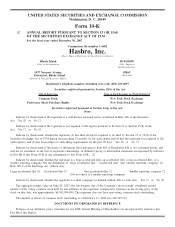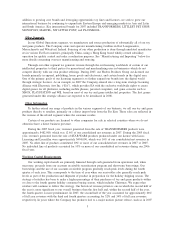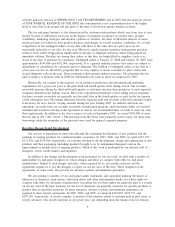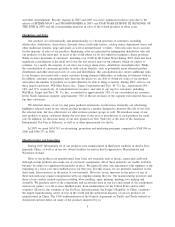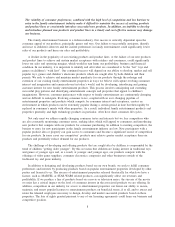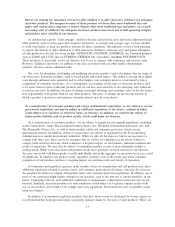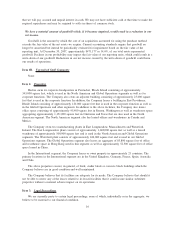Hasbro 2007 Annual Report Download - page 16
Download and view the complete annual report
Please find page 16 of the 2007 Hasbro annual report below. You can navigate through the pages in the report by either clicking on the pages listed below, or by using the keyword search tool below to find specific information within the annual report.The volatility of consumer preferences, combined with the high level of competition and low barriers to
entry in the family entertainment industry make it difficult to maintain the success of existing products
and product lines or consistently introduce successful new products. In addition, an inability to develop
and introduce planned new products and product lines in a timely and cost-effective manner may damage
our business.
The family entertainment business is a fashion industry. Our success is critically dependent upon the
consumer appeal of our products, principally games and toys. Our failure to successfully anticipate, identify
and react to children’s interests and the current preferences in family entertainment could significantly lower
sales of our products and harm our sales and profitability.
A decline in the popularity of our existing products and product lines, or the failure of our new products
and product lines to achieve and sustain market acceptance with retailers and consumers, could significantly
lower our sales and operating margins, which would in turn harm our profitability, business and financial
condition. In our industry, it is important to identify and offer what are considered to be the “hot” toys and
games on children’s “wish lists”. Our continued success will depend on our ability to develop, market and sell
popular toys, games and children’s electronic products which are sought after by both children and their
parents. We seek to achieve and maintain market popularity for our products through the redesign and
extension of our existing family entertainment properties in ways we believe will capture evolving consumer
interest and imagination and remain relevant in today’s world, and by developing, introducing and gaining
customer interest for new family entertainment products. This process involves anticipating and extending
successful play patterns and identifying entertainment concepts and properties that appeal to children’s
imaginations. However, consumer preferences with respect to family entertainment are continuously changing
and are difficult to anticipate. Evolving consumer tastes, coupled with an ever changing pipeline of
entertainment properties and products which compete for consumer interest and acceptance, creates an
environment in which products can be extremely popular during a certain period in time but then rapidly be
replaced in consumer’s minds with other properties. As a result, individual family entertainment products and
properties generally, and high technology products in particular, often have short consumer life cycles.
Not only must we address rapidly changing consumer tastes and interests but we face competitors who
are also constantly monitoring consumer tastes, seeking ideas which will appeal to consumers and introducing
new products that compete with our products for consumer purchasing. In addition to existing competitors, the
barriers to entry for new participants in the family entertainment industry are low. New participants with a
popular product idea or property can gain access to consumers and become a significant source of competition
for our products. In some cases our competitors’ products may achieve greater market acceptance than our
products and potentially reduce demand for our products.
The challenge of developing and offering products that are sought after by children is compounded by the
trend of children “getting older younger”. By this we mean that children are losing interest in traditional toys
and games at younger ages and, as a result, at younger and younger ages, our products compete with the
offerings of video game suppliers, consumer electronics companies and other businesses outside of the
traditional toy and game industry.
In addition to designing and developing products based on our own brands, we seek to fulfill consumer
preferences and interests by producing products based on popular entertainment properties developed by other
parties and licensed to us. The success of entertainment properties released theatrically for which we have a
license, such as MARVEL or STAR WARS related products, can significantly affect our revenues and
profitability. If we produce a line of products based on a movie or television series, the success of the movie
or series has a critical impact on the level of consumer interest in the associated products we are offering. In
addition, competition in our industry for access to entertainment properties can lessen our ability to secure,
maintain, and renew popular licenses to entertainment products on beneficial terms, if at all, and to attract and
retain the talented employees necessary to design, develop and market successful products based on these
properties. The loss of rights granted pursuant to any of our licensing agreements could harm our business and
competitive position.
8



